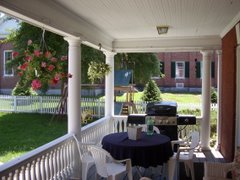Carved in Stone
The Artistry of Early New England
Gravestones
There is something eerily stimulating about thumbing
through, Carved in Stone (Gilson, T.E.
& Gilson, W., 2012, University Press of New England) the book of photos
of New England gravestones by Thomas E. Gilson, with an essay on their history
and style by William Gilson. The Gilson brothers were born and raised in
Connecticut. Thomas Gilson taught
photography in Vermont for 17 years. What
started as a curious hobby of T. Gilson turned out to be a compilation of early
colonial American history in photographs.
In his book Gilson shows us colonial American sculpture in its earliest
form. The stories the pictures tell
share not only the hardships and fears of colonial times but also hope and accomplishments.
The essay written by William Gilson shares a common desire to understand not
only the messages and symbols carved into the stones but also pay tribute to
the artwork of the carvers.
As a society we are squeamish when discussing death, yet we
sentimentalize death with depictions of angels, soft light and our idea of
heaven. The men and women of 17th and 18th
century New England viewed death with a fear that is seen on their
gravestones. Skeletons, teeth-baring
devils and skulls with eerie eye sockets tell of uncertainty and dread about
what really lies beyond this mortal soil. Interestingly they did not waste any
space on their gravestones with such euphemisms as “passed away” or “gone” as
we see on later and present day stones.
The early settlers of New England lived in a place and time
where death was always present. Disease
and violence were present on a daily basis. They feared hell and the eternal damnation of
their souls. It is no wonder that so many of their gravestones reflected the
anxiety of living in a harsh, unpredictable world. “O! [Relentless] Death” is an
inscription on one gravestone shown in the book (Gilson, 2012 pp110), and it
reads like a cry of despair. Still not all the gravestones are so gloomy or the
depictions on them as grim. Although the
Puritans’ held stern ideas against human weakness and sin there was hope that a
more glorious and generous world that awaited them after death. Many Puritan
gravestones show a “Death Head” or a carved face or skull with wings on either
side of the head. This symbol states the
soul is ascending to heaven, and the occupant was a believer in heaven.
Eventually, as Puritanism waned in the early 18th
century, the Death's Head imagery faded and new carvings of cherubs
(symbolizing a child) and then later to urns with weeping willows over them, representing
the mourning of the loss of life. Some of the headstones show rising
suns(Gilson, 2012 pp 22,81), their light presumably shining on the dead; angel
faces that are neither male nor female but still sweet and childlike (Gilson,
2012 pp 34,35) and crude faces that look like the stone heads of Easter Island(Gilson,
2012 pp112). In one remarkable carving(Gilson,
2012 pp 44), a young woman wearing her hair down on her shoulders, not pinned
up or hidden behind a cap, holds a flower. Even carved in stone she radiates
with life. In a period of; crude medical
treatments, chronic wasting diseases, short life expectancies and a high
mortality rate the promise of an after-life without pain or suffering must have
seemed like true salvation. Some of the carvings are not as sophisticated, they
have had a rough life different from the modern, polished headstones. These were tough and judgmental people who
fought for survival and their gravestones reflect their unbending spirit.
Thomas Gilson’s black and white photographs are elegant and
show unexpected and humorous details in the carvings and the texts written on the
gravestones. William Gilson’s text is nostalgic and thoughtful. Thomas’ photography and William’s essay about
gravestones offers an unexpected journey into the spiritual and mental
state of colonial American people. While both pay
tribute to the craftsman who created these story-telling sculptures by
compiling this book they also feed a curiosity for death that is as timeless as
death itself.

No comments:
Post a Comment